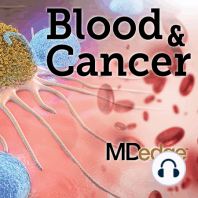25 min listen
Is this a good study? The statistics tell the story
FromBlood & Cancer
ratings:
Length:
32 minutes
Released:
Mar 5, 2020
Format:
Podcast episode
Description
Ever read through a study and wondered how to apply the hazard ratio, or if you should change your practice because of a secondary endpoint finding? In this episode, Lauren M. Catalano, MD, of the University of Pennsylvania, Philadelphia, explains all the common terms and why they matter in the context of the KEYNOTE-024 trial. In Clinical Correlation, Ilana Yurkiewicz, MD, of Stanford (Calif.) University, talks about how to prepare for an unexpected bad outcome. Practice points: Don’t skip over the statistical analysis portion of a paper. Use Google to find simple definitions for unfamiliar biostatistics terms. Understanding the statistical elements is essential to determining the quality of the research. * * * Understanding statistics in the context of KEYNOTE-024 Article discussed: Updated analysis of KEYNOTE-024: Pembrolizumab versus platinum-based chemotherapy for advanced non–small cell lung cancer with PD-L1 tumor proportion score of 50% or greater. J Clin Oncol. 2019 Mar 1;37(7):537-46. Primary endpoint: The outcome that is necessary to ensure the efficacy of the trial. What is the study’s objective? The primary endpoint is defined prior to starting the study, which influences how many patients need to be enrolled to ensure statistical significance. This paper’s primary endpoint: Time since random assignment to disease progression or death. Secondary endpoint: These are interesting trends or observations that the investigators were able to determine, but for which the original study may not have been powered, meaning that they may not have enough data to determine the statistical significance. This paper’s secondary endpoints: Objective response rate (confirmed complete and partial responses) and safety. Hazard ratio: “Ratio” suggests that this is a comparison between the intervention and control arm. HR is a measure of an effect or intervention on the outcome of interest over a period of time (risk per unit of time). The outcome can be positive or negative. Confidence interval: Since it is not possible to survey the entire population, a confidence interval provides a range of values where the true value most likely falls. If the confidence interval crosses “1” then there is no difference between the arms of the study. Kaplan-Meier curve: Often used to illustrate survival. This is a graphical representation of hazard ratio, usually drawn as a step function. P value: The degree of error that we are willing to accept. Often P = .05, which means we are willing to accept a 5% risk that the hypothesis is incorrect. Crossover: Patients assigned in one arm of the study (usually the control arm) can be reassigned to the other arm (usually the intervention group). Intention to treat: A technique used in randomized, controlled trials in which patient outcomes are compared within the group the patient was originally assigned to. This may not reflect the treatment that the patient actually received. If the patient is in a group that is treated but then leaves that group, they are still counted in the original group. Show notes by Ronak Mistry, DO, resident in the department of internal medicine, University of Pennsylvania, Philadelphia. * * * For more MDedge Podcasts, go to mdedge.com/podcasts Email the show: podcasts@mdedge.com Interact with us on Twitter: @MDedgehemonc David Henry on Twitter: @davidhenrymd Ilana Yurkiewicz on Twitter: @ilanayurkiewicz
Released:
Mar 5, 2020
Format:
Podcast episode
Titles in the series (100)
Practice-changing research in GI cancer: , of the University of Pennsylvania, Philadelphia, joins Blood & Cancer host , also of the University of Pennsylvania, to review the top three GI cancer trials presented at the 2019 ESMO World Congress on Gastrointestinal Cancer, and how they are... by Blood & Cancer
